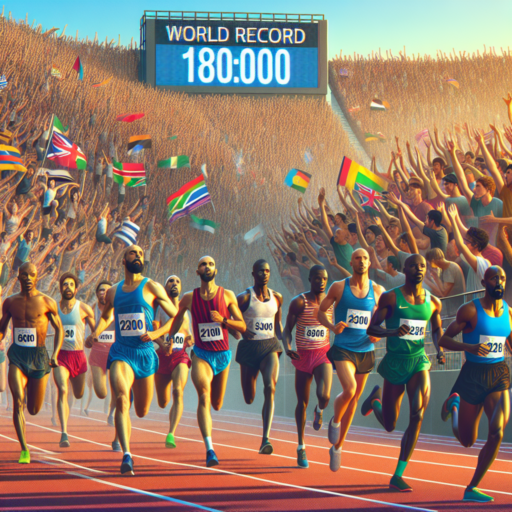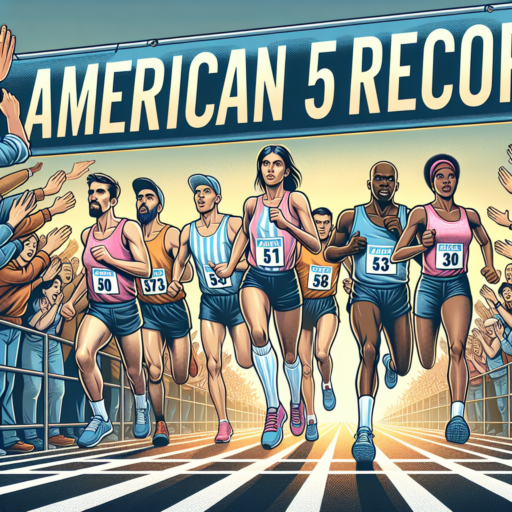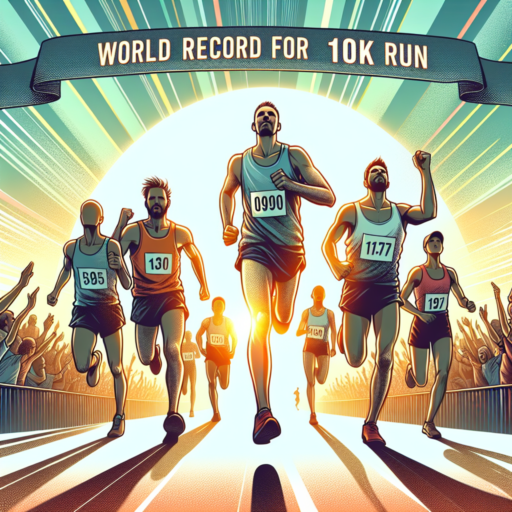Introduction to the World Record for 10K
The 10K run, a pivotal distance in the pantheon of athletics, commands a unique blend of speed, stamina, and unwavering determination from its participants. The world record for the 10K, both on the track and road, stands as a testament to human potential and athletic prowess. This record not only encapsulates the sheer physical capability of the record holders but also the evolution of training methodologies, nutritional advancements, and running technology over the years.
Historically, the 10K world record has been an ever-moving target, with athletes from various corners of the globe etching their names into the annals of distance running. The endeavor to lower the threshold of what is possible in the 10K has made this event a focal point for the athletic community, drawing in not just runners but enthusiasts, coaches, and sports scientists all dedicated to pushing the boundaries of human speed and endurance.
Understanding the significance of the world record for the 10K requires a deep dive into the performances that have shaped it. Each record-setting run is a story of perfect conditions: from the weather, to the competition, and even the psychological state of the athlete. These factors all converge in a fleeting moment of athletic perfection, propelling the runner into history. The record’s evolution reflects not only advancements in the sport but also changes in how athletes prepare for and execute their races.
The History of the 10K World Record
The legacy of the 10K world record is a fascinating journey that mirrors the evolution of athletic performance and the unyielding human spirit to push beyond perceived limits. The record’s history is not just a chronological listing of times and names; it represents moments where athletes have broken barriers thought impossible, setting new standards for generations to come.
Initially, the 10K world record was unofficial, as official record-keeping by bodies like the International Association of Athletics Federations (IAAF) only began in the early 20th century. Since then, the record has been broken repeatedly, with each athlete contributing to the ever-expanding limits of human speed and endurance. Over the decades, advancements in training methodologies, nutrition, and running technology have played pivotal roles in aiding athletes in their quest to etch their names into history.
One of the landmark moments in the history of the 10K world record came during the mid-20th century when Emil Zátopek, known as the Czech Locomotive, shattered existing records and set a new standard for long-distance running. His unique training techniques and incredible stamina laid the groundwork for future athletes to dream bigger. Following Zátopek, the record has seen numerous revisions, each time inching closer to the sublime barrier of human speed and endurance.
No se han encontrado productos.
Current Men’s 10K World Record Holder
Introduction to the 10K Record Phenomenon
The 10K race is a pivotal test of speed, endurance, and strategy, attracting elite athletes from around the globe. The pursuit of the 10K world record has seen incredible talents push the boundaries of what is humanly possible, creating moments of sheer amazement in the world of athletics. This feat not only requires exceptional physical fitness but also a strong mental game, as competitors chase down the clock over 10 kilometers.
Breaking the Barrier
In recent years, the men’s 10K world record has seen fierce competition, with athletes edging closer to breaking the previously unthinkable barriers. Advances in training, nutrition, and running technology all contribute to these astonishing achievements. The title of Current Men’s 10K World Record Holder is a coveted position that stands as a testament to human endurance and persistence. It’s a record that many strive for, but only a select few can claim.
The Record Holder’s Journey
Holding the world record in the 10K is a source of immense pride and signifies a major accomplishment in an athlete’s career. The journey to becoming the Current Men’s 10K World Record Holder is fraught with challenges, requiring years of dedicated training and the ability to perform under pressure. Every second counts in the race, and the margin for error is slim. For the current holder, reaching this summit was not just about the physical training but mastering the art of race pacing and understanding their competitors’ strategies.
How the Women’s 10K World Record Has Evolved
The journey of the Women’s 10K World Record is a fascinating narrative of human achievement, perseverance, and the continual shattering of boundaries thought to be unreachable. Over the years, this record has not only been broken repeatedly but has also served as a platform to showcase the incredible potential and dedication of female athletes across the globe. The evolution of this record is not just a series of numbers; it’s a reflection of the progress in training methodologies, nutrition, and the undying spirit of competition among women runners.
Initially, the record was perceived as a pinnacle that few could aspire to. However, as training techniques evolved and a deeper understanding of the athletes’ physical and mental capabilities developed, remarkable improvements were seen. Innovations in sports science and nutrition played substantial roles in this evolution, allowing athletes to perform at levels previously thought impossible. Each new record set has been a testament to the adaptability and resilience of female athletes, pushing the boundaries and setting new goals for the entire athletics community.
Historical milestones in the evolution of the Women’s 10K World Record are not just numbers; they are storied efforts that have inspired countless athletes worldwide. These milestones mark periods of significant change, not only in the record itself but also in the broader sports world, reflecting shifts in societal attitudes towards women in sports and the increasing professionalization and visibility of women’s athletics. The record’s evolution is a mirror to the growing recognition and celebration of female athletes’ achievements, signaling a brighter future for women’s sports at all levels.
Training Techniques for a 10K World Record Attempt
When aiming for a 10K world record, your training techniques need to be as precise and dedicated as the goal itself. One crucial aspect to consider is interval training. This involves short bursts of high-intensity running followed by a rest or slower running period. Interval training increases both aerobic and anaerobic fitness, crucial for improving your time in a 10K run.
Another essential technique is tempo runs. These are sustained effort runs at a pace you can hold for a significant duration but not quite your 10K race pace. The idea is to push your lactate threshold further, improving your body’s efficiency at clearing out lactate and thus, delaying fatigue during your race. Incorporating tempo runs into your routine builds endurance and speed, two pillars for breaking records.
Lastly, strength and conditioning exercises cannot be overlooked. They are vital for improving your overall running economy and reducing the risk of injury. Focus on core strength, as well as leg strength, to ensure your body can handle the rigors of high-intensity training without breaking down. Consistent strength training complements your running routine and is a keystone in preparing for a record attempt.
Diet and Nutrition for Elite 10K Runners
Optimizing diet and nutrition is pivotal for 10K runners aiming for elite performance. The right balance of macronutrients — carbohydrates, proteins, and fats — plays a crucial role in energy sustenance, recovery, and overall health. Carbohydrates are especially important, serving as the primary energy source during both training and competition. Elite runners focus on complex carbohydrates such as whole grains, vegetables, and fruits to ensure a steady release of energy.
Protein intake is also vital for recovery and muscle repair. Sources like lean meats, fish, legumes, and dairy help in rebuilding muscle fibers torn during intense training. Incorporating a variety of protein sources ensures the supply of all essential amino acids, aiding in faster recovery and reduced muscle soreness. Additionally, healthy fats from sources like avocados, nuts, and seeds are integral for long-term energy, hormone production, and absorption of fat-soluble vitamins.
Hydration holds a special place in the diet of elite 10K runners. Maintaining optimal hydration levels before, during, and after races and training sessions cannot be overstated. Electrolyte balance, critical for muscle function and blood volume maintenance, is managed through adequate fluid intake and, when necessary, supplemented by electrolyte solutions. This strategic approach to nutrition and hydration ensures that 10K runners can perform at their peak while minimizing the risks of injury and overtraining.
Technology and Gear in Breaking the 10K World Record
The realm of athletics constantly evolves, with breakthroughs in technology and gear playing pivotal roles. When it comes to breaking the 10K world record, every second counts, and the marginal gains afforded by advanced technology and innovative gear can make all the difference. Athletes and their coaching teams delve into the minutiae of performance enhancement, leveraging every possible advantage to shave off milliseconds.
From the design of running shoes to the fabrication of lightweight, aerodynamic clothing, the progression in technology has been instrumental. Modern running shoes, for example, are the product of exhaustive research and testing, incorporating materials that optimize energy return and diminish fatigue. These shoes are not just about comfort; they’re engineered to maximize an athlete’s efficiency over the grueling 10,000-meter distance. Additionally, the use of wearable technology allows athletes to monitor and analyze every aspect of their training and recovery, tailor-making programs that push the envelope on their performance capabilities.
Another significant advancement is in the arena of nutrition and hydration strategies, informing athletes on the optimal intake to enhance endurance and recovery. The integration of these strategies with cutting-edge gear and wearable tech ensures that athletes are performing at their peak, with every variable accounted for. Far from being just about physical endurance and mental fortitude, breaking the 10K world record is a testament to how far we’ve come in the science of athletic performance.
Famous 10K Races Known for Fast Times
When it comes to setting personal bests and breaking records, certain 10K races stand out for their reputation for fast times. These events, celebrated worldwide, attract elites and amateurs motivated by the prospect of pushing their limits on speedy courses. From the scenic routes of Europe to the flat, fast streets of the U.S., these races have become bucket-list events for serious runners seeking to achieve a personal milestone or to witness top athletes in action.
Apart of the allure of these renowned 10K races lies in their meticulously planned courses, often designed to be as flat and fast as possible, minimizing challenging elevations and maximizing runners’ ability to maintain pace. Moreover, favorable weather conditions during these events further contribute to the perfect setting for record-breaking performances. It’s not just the elite runners who benefit from such conditions; amateur participants too find these races ideal for surpassing their personal records.
Organizational excellence also plays a critical role in the reputation of these 10K events. From the starting gun to the finish line, every detail is orchestrated to enhance performance. This includes optimal wave starts, ensuring runners of similar speeds are grouped together, to the provision of pacers who guide participants to achieve their target times. The synergy of a supportive crowd, combined with top-notch race logistics, creates an electrifying atmosphere that propels runners to fast finishes.
Future Prospects: Who Will Break the Next 10K World Record?
The quest for the next 10K world record is as competitive as ever, with a slew of elite athletes eyeing this prestigious mark. The current record has stood unchallenged for some time, but given the rapid advancements in training methodologies, nutrition, and running technology, it’s not a question of if, but when and who will rewrite the history books. Identifying the potential candidates is a challenging task given the deep talent pool, but several runners have shown promising signs that they could be the ones to watch.
Rising stars in long-distance running have been consistently breaking their personal bests, and some have come tantalizingly close to the existing 10K world record. Their performances in recent international competitions have been nothing short of extraordinary, making it clear that the potential for a new world record holder among them is significant. These athletes have not only demonstrated incredible physical endurance but also the mental fortitude required to compete at the highest level, marking them as the ones to follow in the race to break the existing world record.
Given the variables that can affect the outcome of any attempt at the record, including weather conditions, the chosen race venue, and competition dynamics, predicting the next world record holder is complex. However, the dedication, resilience, and sheer talent of these leading contenders suggest that the 10K world record is poised for a groundbreaking update soon. As we look forward to this exciting prospect, the anticipation and speculation only add to the intrigue of what is to come in the world of long-distance running.
Frequently Asked Questions About the 10K World Record
The 10K world record is a subject of much fascination and intrigue, drawing questions from athletes, enthusiasts, and sports statisticians alike. Given the exceptional caliber of athleticism required to set such a record, it’s no surprise that people are eager to learn more about the specifics behind these phenomenal achievements. Here, we dive into some of the most frequently asked questions surrounding the illustrious 10K world record.
Who Currently Holds the 10K World Record?
The 10K world record is an honor bestowed upon the fastest runners over this distance on both track and road surfaces. Throughout the years, these records have been broken and reestablished as athletes continue to push the boundaries of human speed and endurance. To keep up with the latest record-holders, athletics governing bodies such as World Athletics maintain up-to-date listings and announcements.
How Has the 10K World Record Progressed Over Time?
The evolution of the 10K world record is a testament to the advancements in training, nutrition, and race strategies over the years. Each new record set not only represents a remarkable personal achievement for the athletes involved but also pushes the sport as a whole towards greater heights. Observing the progression of these records offers insight into how competitive running has developed and what might be expected in the future.
What Role Do Factors Like Technology and Altitude Play?
Technology and altitude are among the key elements that can influence performance in long-distance running events such the 10K. Innovations in running gear, particularly shoes, have been credited with enabling athletes to run faster and longer by improving energy efficiency and reducing injury risk. Meanwhile, training and competing at high altitudes is known to enhance athletes’ oxygen-carrying capacity, albeit these conditions can also present unique challenges.




